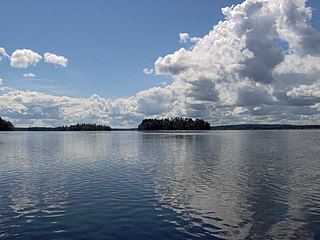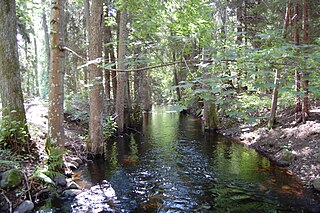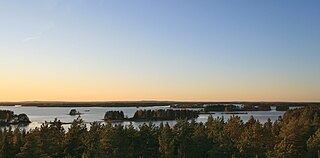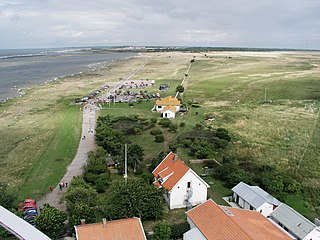 W
WÅnnsjön is a lake in Åre Municipality in Jämtland County, Sweden. By road it is located 154 kilometres (96 mi) northwest of Östersund. The lake and surrounding wetlands are rich in fish, water birds and other wildlife. There are remains of human habitation in the region since the Stone Age, including petroglyphs that are among the oldest in Sweden. In the late 19th century there were attempts to drain the wetlands for use in agriculture and forestry, but this is now being reversed. The lake and surroundings is a protected Natura 2000 area, and attracts many birdwatchers.
 W
WÅsnen is a large lake in southern Småland, Sweden, roughly 150 km² in size. The river Mörrumsån flows south from Åsnen into the Baltic Sea. The lake lies south of Alvesta and Växjö and northwest of Tingsryd and is the third-largest lake in Småland, after Vättern and Bolmen. Approximately 19 km² of the lake's area is occupied by small islands. Åsnen has many small bays and islands, the largest of which is Sirkön. The lake has been designated as a Ramsar site since 1989. The lake is home to Åsnen National Park, established in 2018.
 W
WBlekinge archipelago is an archipelago in the Baltic Sea, located in Blekinge in the south of Sweden.
 W
WBråviken is a bay of the Baltic sea that is located near Norrköping in Östergötland, Sweden. It is an example of a fjard, a drowned shallow glacial valley.
 W
WEmån is a stream in southern Sweden, rising just north of Bodafors in the highlands of Småland and running approximately 229 kilometers to the Baltic Sea just south of Oskarshamn.
 W
WFärnebofjärden National Park is a Swedish national park traversed by the river Dalälven, about 140 km (87 mi) north of Stockholm. It covers 10,100 ha, of which 4,110 ha aquatic, on the frontier between the counties of Dalarna and Gävleborg.
 W
WGetterön Nature Reserve is a nature reserve at Getterön in Varberg Municipality, Sweden. It consists of parts of the peninsula Getterön and an area to the north. It has an area of 350 hectares, of which 235 are land. The reserve was established in 1970.
 W
WThe Göta älv is a river that drains lake Vänern into the Kattegat, at the city of Gothenburg, on the western coast of Sweden. It was formed at the end of the last glaciation, as an outflow channel from the Baltic Ice Lake to the Atlantic Ocean and nowadays it has the largest drainage basin in Scandinavia.
 W
WGotland, also historically spelled Gottland or Gothland, is Sweden's largest island. It is also a province, county, municipality, and diocese. The province includes the islands of Fårö and Gotska Sandön to the north, as well as the Karlsö Islands to the west. The population is 58,595, of which about 23,600 live in Visby, the main town. The island of Gotland and the other areas of the province of Gotland make up less than one percent of Sweden's total land area.
 W
WThe river Helge or, in Swedish, Helgeån, alternatively Helge å, (lit. 'The Holy river') is a river which flows through Småland and Skåne in southern Sweden. The course of the river takes it through Kristianstad and out to the Hanöbukten in the Baltic Sea.
 W
WHenvålen Nature Reserve is a nature reserve in Jämtland County in Sweden. It is part of the EU-wide Natura 2000-network and parts of the wetland areas are designated Ramsar sites.
 W
WLake Hornborga is a lake in Västergötland in Sweden, famous for its many birds, in particular the many cranes that stay here temporarily during their annual migrations.
 W
WLundåkrabukten is a bight located at the eastern part of central Øresund, the sound between Danish Zealand and Swedish Scania. The bight is usually defined as the sea area between the Barsebäck peninsula in the South and Landskrona harbour and the artificial island known as Gråen in the North. Its area covers around 50 km2, and some 40% isn't deeper than 3 meters. There is no part deeper than 20 meters and the coastlines are very flat. Most of the seafloor is covered with sand. There is not even a minor fishing port along its shores, and the bight isn't particularly popular for summertime bathing either. The nearby Barsebäck Golf & Country Club, which at many occasions has hosted Scandinavian Masters and once Solheim Cup Golf competitions, has three seaside link holes at the shores of Lundåkrabukten.. The Barsebäck Nuclear Power Plant, that produced electricity between 1975 and 2006, has been the major landmark in the bight's southern end. As it was located just some 15 km from central Copenhagen and as Denmark never build any nuclear power plants of their own, the power plant became a Danish-Swedish battle issue for several decades.
 W
WMörrumsån is a river in Blekinge County and Kronoberg County, Sweden. It is roughly 185 km long, with its tributary in the lake Asnen, from which it flows south, into the Baltic Sea. The river is known among fishing enthusiasts around the world, because of the salmon fishing that is considered to be among the best in Sweden. The most prominent villages where the river flows through are Mörrum and Svängsta, both located in Karlshamn Municipality.
 W
WÖland is the second largest Swedish island and the smallest of the traditional provinces of Sweden. Öland has an area of 1,342 square kilometres and is located in the Baltic Sea just off the coast of Småland. The island has 26,000 inhabitants. It is separated from the mainland by the Kalmar Strait and connected to it by the 6-kilometre (3.7 mi) Öland Bridge, which opened on 30 September 1972.
 W
WOttenby is a town on the island of Öland, Sweden, located in Ås parish, Mörbylånga Municipality in Kalmar County. Ottenby is located just north of the southern tip of Öland, over three miles south of the area's main town, Mörbylånga. Ottenby is also the name of the mansion and a royal demesne, now a nature reserve.
 W
WRoxen is a medium-sized lake in south-central Sweden, east of Lake Vättern, part of the waterpath Motala ström and the Göta Canal. South of Lake Roxen is the city Linköping.
 W
WThe Stockholm archipelago is the largest archipelago in Sweden, and the second-largest archipelago in the Baltic Sea. Part of the archipelago has been designated as a Ramsar site since 1989.
 W
WStore Mosse is a national park in Småland in southern Sweden, located in the municipalities of Vaggeryd, Gnosjö and Värnamo. In total Store Mosse covers some 100 km2 (39 sq mi); of these, some 77 km2 (30 sq mi) were designated national park in 1983.
 W
WLake Tåkern is a lake in Östergötland County, Sweden. It is considered one of northern Europe's foremost bird lakes. It is 12 km (7.5 mi) long and 8 km (5 mi) wide, with an average depth only 0.8 metres (2.6 ft). The lake lies around 20 km (12.4 mi) west of Mjölby, bordering in the west to Omberg. The whole lake, with the surrounding beaches, has been a nature reserve since 1975. From April to the end of July, it is not open to the public, except for visiting areas and walking routes.
 W
WTräslövsläge is a locality situated in Varberg Municipality, Halland County, Sweden, with 2,600 inhabitants in 2010.
 W
WTysjöarna Nature Reserve is a nature reserve in Jämtland County in Sweden. It is part of the EU-wide Natura 2000-network, and has been designated as a Ramsar site since 2001.
 W
WThe Vindel River is a river in northern Sweden. It is a tributary to Ume River and the biggest tributary river in Sweden. It lends its name to the Vindelfjällens Nature Reserve, one of the largest protected areas in Europe, totaling 562,772 ha. Since it is partially located with the reserve, it is permanently protected from hydroelectric development. Downstream from where Vindelälven merges with Umeälven Sweden's largest hydropower plant is located. Considering that the river is not unregulated all the way to the ocean, but just in the part of it formally called Vindelälven, the decision to call it "unregulated" or "permanently protected from hydropower" is to be taken with a grain of salt.The river Vindel and its tributaries were important routes for transporting timber in northern Sweden, up until 1976. To ease the movement of logs downstream, wooden dams were constructed, side streams were cut off and tributaries were straightened and cleared. These changes significantly affected the river ecosystem and populations of wild fish, mammals, mussels and other species of aquatic and riparian habitats. The changes therefore negatively impact the favourable conservation status of species and habitats within the Vindel River Natura 2000 network site. Actions to restore the tributaries of the Vindel River to a more natural state are considered a priority by the Swedish environmental protection agency, the Västerbotten county administrative board, and the EU under the Habitats Directive and the Water Framework Directive (WFD).The general objective of the Vindel River LIFE project was to achieve a ‘good status’ for the waters of the Vindel River with reference to the Water Framework Directive, and ‘good conservation status’ for the species in the project area under the Habitats Directive. The aim was to reduce the negative impacts of fragmentation and channelisation caused by timber-floating infrastructure in tributaries of the Vindel River system. The work was focused on a number of river stretches, altogether spanning just over 44 km, with the aim of removing 73% of the obstructions to natural river flow, placing large boulders and fallen trees in the water to simulate natural conditions and to reconnect streams to the tributaries to open up breeding areas for migrating fish.The Vindel River LIFE project restored streams in the tributaries of the Vindel River basin, by removing timber-floating infrastructure, replacing large obstacles into the water, and creating and restoring fish spawning grounds. These ecosystem restoration measures resulted in improved water quality, and improvements in conditions for protected species, in line with national and EU policy. The project’s work had clear socio-economic benefits in the project area.
 W
WThe Vindelfjällen Nature Reserve is a nature reserve located in the municipalities of Sorsele and Storuman in Västerbotten County of Swedish Lapland. It is the largest natural reserve in Sweden and one of the largest protected areas in Europe, totaling 562,772 ha.